Guest post by John Hall
Many people are fascinated by the mythology of Atlantis, the legend that there was once an entire continent that was lost to the rest of the world when Atlantis sunk beneath the waves during some awful, ancient cataclysm. Less widely appreciated however, is the fact that the icy wastes of Antarctica represent a real-life Atlantis – real in the sense that Antarctica truly is a “lost continent”, a world completely obliterated by an ancient climate disaster. Around 35 million years ago (well after the age of dinosaurs), the last remnants of the super-continent of Gondwana broke apart to form the modern continents of Antarctica, South America and Australia. This rifting of the continents allowed a new cold-water ocean current to begin circulating around Antarctica’s polar seas, and it has done so ever since. Ocean currents are a major determining factor of climate, and as the waters around Antarctica cooled, so too did the air temperatures; until eventually the year came when snow that fell in the winter did not melt in the following summer… the icing over of Antarctica had begun. So for most of its long history (any time before 35 million years ago) Antarctica was not the continent of ice and snow that we know today, but rather a warmer and well-vegetated landscape that must have been rich in unique plants and animals. It’s fascinating to wonder what kind of creatures might have lived there over the millennia, but for the most part the evidence has been lost to us, with even their fossils now being buried deep under the polar ice cap. But glimpses into the lost worlds of ancient Antarctica are occasionally provided by the very rare fossils sometimes found in ice-free rocks, and one such example is the remarkable Antarctic dinosaur Cryolophosaurus. Collecta’s model of the “frozen lizard” is the subject of today’s review.
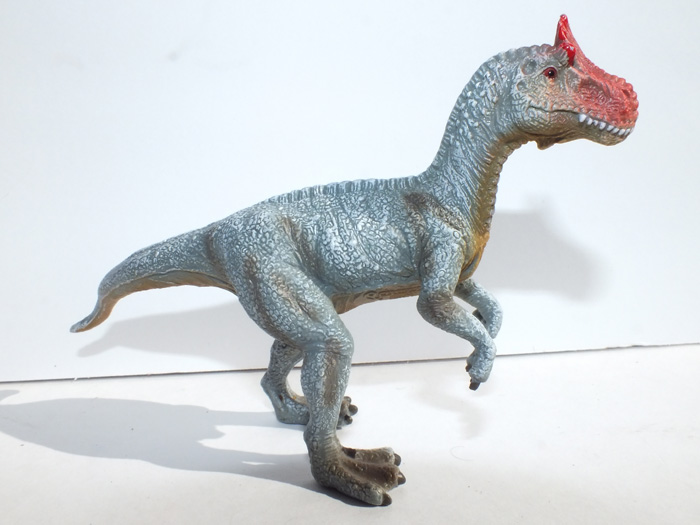
Collecta’s Cryolophosaurus is a well-designed little figure. Despite the small size, this is a lively-looking beast that stands well on its own two feet, with the tail held high. The colour scheme on this guy is simple but effective. The body on my example is a pale grey, dry-brushed almost white; pictures on the internet suggest some versions of this figure are an even more pronounced snowy white, an imaginative and interesting colour choice for a dinosaur. The skin is convincingly textured in tiny scales and wrinkles. The most distinctive feature of Cryolophosaurus was a transverse crest of bone across the top of the head which was too thin to have been used in any sort of physical contest, and hence could only have served as a visual signalling device – perhaps to impress potential mates, intimidate rivals, or to allow cryolophosaurs to instantly recognise others of their kind. In keeping with this ecology, the crest on the Collecta figure is done in a bright, high contrast red which makes absolute sense for a visual display structure. Overall, the colour scheme is distinctive, and makes this figure stand out nicely from other theropod dinosaurs you might have on the shelf.
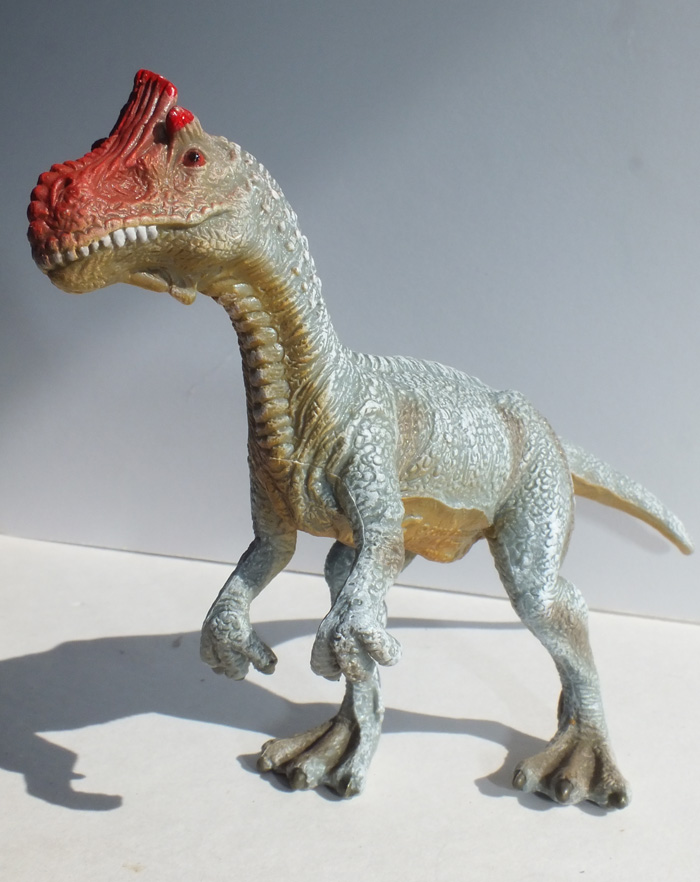
The feet are perhaps over-large (no doubt necessary to make it stand without a tail-prop) and the tail seems a little thin and spindly to me (I mean aesthetically – I make no claims to being an anatomist!). This said, to my eye this is still a more appealing Cryolophosaurus than the larger Carnegie version, which looks very spindly (almost emaciated?) and relies on a ram-rod like tail-prop to make it stand up. The Carnegie Cryolophosaurus is ably reviewed by Plesiosauria here so you can compare the two and make up your own mind.
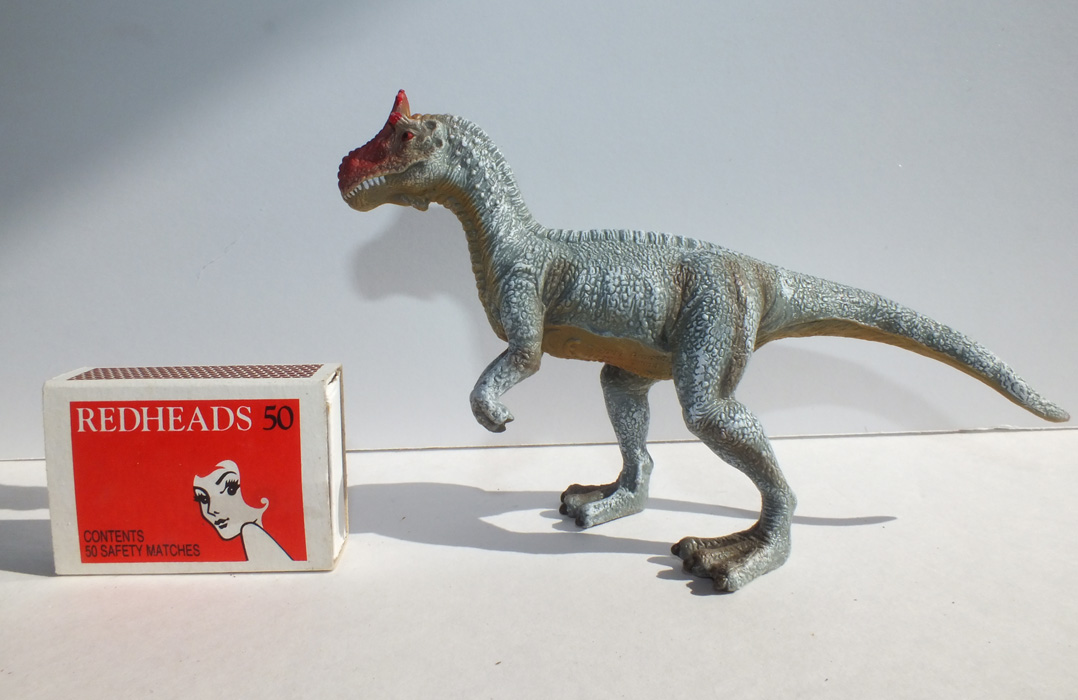
Buyers new to the Collecta range should be aware that this Cryolophosaurus, like many of their figures, is quite small in size. The model is about 14cm long, and since the real animal was around 7 metres long, this would make the scale something like 1:50, give or take. What the best of the Collecta models lack in size, they make up for in good sculpts of interesting dinosaur species at a pleasingly affordable price, and this Cryolophosaurus figure succeeds in meeting these expectations. While perhaps not in the very top tier of the Collecta range, I don’t think this fellow is very far behind, and he would definitely be worth picking up to add to your Collecta herd! The best thing about this figure, and the thing that immediately sets it apart from almost all other figures of carnivorous dinosaurs on the market, is that the jaws are shut. HOORAY!!! I mean seriously, why does every single theropod model out there have to have its jaws wide open at maximum gape, as if it was sitting in the dentist’s chair or belting out a Wagnerian opera? OK, I can understand that roaring theropods are highly marketable, but these animals also look really striking and beautiful with their jaws closed (as they no doubt were for 99% of the time back in the Mesozoic). A round of applause goes to whoever it was at Collecta who sculpted this Cryolophosaurus, for doing a really magnificent job of the head – not only for the closed jaws, but also for the beautiful details of the crest and hornlets, a pair of lively, gleaming eyes and a very charismatic toothy grin. This is a dinosaur model with that elusive quality of character, and for that reason I think kids would love incorporating this guy into their dinosaur play just as much as adults would find him an interesting addition to their collection.
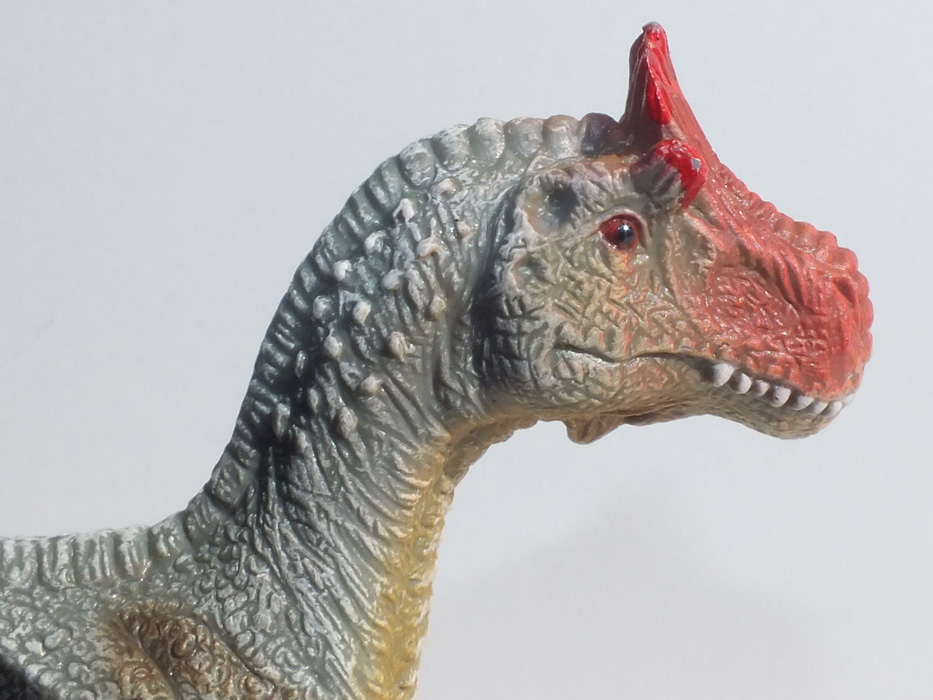
The question of whether this Collecta Cryolophosaurus has any other faults brings us neatly to today’s word of the day, which is “pronated”. If, like me, you had no idea what this obscure anatomical term meant when you first stated reading the dinosaur toy blog, I can tell you that in the context of carnivorous dinosaurs, “pronated” means that the wrists are turned such that the palms face down towards the ground (as they would on a dog, sitting on its hind legs to beg) instead of facing side on to the body (as they do on a person standing with their arms at rest). The hands on the Collecta Cryolophosaurus are indeed pronated, which is a common error in theropod illustrations and models. While this arrangement seems to make intuitive sense to non-anatomists, when you think about it, the writs on a bipedal animal shouldn’t be pronated, as this would make the hands useless for many of the kinds of things a theropod dinosaur might need to do, such as grabbing onto prey, manipulating objects in their environment, or playing a game of scrabble, to quote a purely random example.
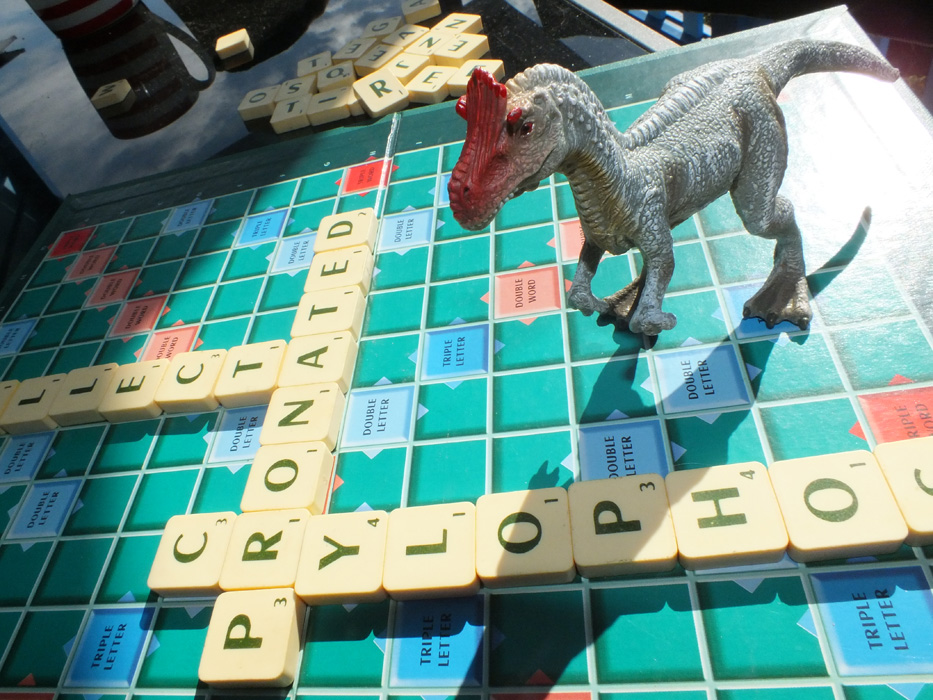
In conclusion, whether you’re in the market for an educational children’s toy, or a display piece for the collector’s shelf, the Collecta Cryolophosaurus represents a lively restoration of a cool and interesting dinosaur at a very affordable price. Here at last is a carnivorous dinosaur sensitively restored – not as an eternally-roaring killing machine – but rather as a real animal, jaws closed, going about its day-to-day life in a vanished world.
Available from Amazon.com here and Ebay.com here.
Disclaimer: links to Ebay and Amazon on the DinoToyBlog are affiliate links, so we make a small commission if you use them. Thanks for supporting us!




Jó kis figura,és tényleg csukott szááj!!Tényleg kevés ilyen van,de például a Safari yutyrannus is ilyen(fehér szín és csukott száj).
Az egyetlen nagy probléma a rettenetes pronált kar!
[…] many truly excellent dinosaur models (for example, I have written favourable reviews for their Cryolophosaurus and Nothronychus) but this Stegosaurus, (representing one of their older sculpts) is not one of […]